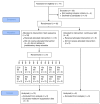Temporal integration of light flashes by the human circadian system
- PMID: 26854928
- PMCID: PMC4767340
- DOI: 10.1172/JCI82306
Temporal integration of light flashes by the human circadian system
Abstract
Background: Beyond image formation, the light that is detected by retinal photoreceptors influences subcortical functions, including circadian timing, sleep, and arousal. The physiology of nonimage-forming (NIF) photoresponses in humans is not well understood; therefore, the development of therapeutic interventions based on this physiology, such as bright light therapy to treat chronobiological disorders, remains challenging.
Methods: Thirty-nine participants were exposed to 60 minutes of either continuous light (n = 8) or sequences of 2-millisecond light flashes (n = 31) with different interstimulus intervals (ISIs; ranging from 2.5 to 240 seconds). Melatonin phase shift and suppression, along with changes in alertness and sleepiness, were assessed.
Results: We determined that the human circadian system integrates flash sequences in a nonlinear fashion with a linear rise to a peak response (ISI = 7.6 ± 0.53 seconds) and a power function decrease following the peak of responsivity. At peak ISI, flashes were at least 2-fold more effective in phase delaying the circadian system as compared with exposure to equiluminous continuous light 3,800 times the duration. Flashes did not change melatonin concentrations or alertness in an ISI-dependent manner.
Conclusion: We have demonstrated that intermittent light is more effective than continuous light at eliciting circadian changes. These findings cast light on the phenomenology of photic integration and suggest a dichotomous retinohypothalamic network leading to circadian phase shifting and other NIF photoresponses. Further clinical trials are required to judge the practicality of light flash protocols.
Trial registration: Clinicaltrials.gov NCT01119365.
Funding: National Heart, Lung, and Blood Institute (1R01HL108441-01A1) and Department of Veterans Affairs Sierra Pacific Mental Illness Research, Education, and Clinical Center.
Figures





Similar articles
-
Duration invariance and intensity dependence of the human circadian system phase shifting response to brief light flashes.Proc Biol Sci. 2022 Mar 9;289(1970):20211943. doi: 10.1098/rspb.2021.1943. Epub 2022 Mar 9. Proc Biol Sci. 2022. PMID: 35259981 Free PMC article.
-
Efficacy of a single sequence of intermittent bright light pulses for delaying circadian phase in humans.Am J Physiol Endocrinol Metab. 2004 Jul;287(1):E174-81. doi: 10.1152/ajpendo.00385.2003. Epub 2004 Mar 23. Am J Physiol Endocrinol Metab. 2004. PMID: 15039146 Free PMC article. Clinical Trial.
-
Melatonin rhythm observed throughout a three-cycle bright-light stimulus designed to reset the human circadian pacemaker.J Biol Rhythms. 1999 Jun;14(3):237-53. doi: 10.1177/074873099129000560. J Biol Rhythms. 1999. PMID: 10452336
-
Human circadian rhythms: physiological and therapeutic relevance of light and melatonin.Ann Clin Biochem. 2006 Sep;43(Pt 5):344-53. doi: 10.1258/000456306778520142. Ann Clin Biochem. 2006. PMID: 17022876 Review.
-
Resetting the melatonin rhythm with light in humans.J Biol Rhythms. 1997 Dec;12(6):556-67. doi: 10.1177/074873049701200610. J Biol Rhythms. 1997. PMID: 9406030 Review.
Cited by
-
Circadian Responses to Fragmented Light: Research Synopsis in Humans.Yale J Biol Med. 2019 Jun 27;92(2):337-348. eCollection 2019 Jun. Yale J Biol Med. 2019. PMID: 31249494 Free PMC article. Review.
-
Light Modulation of Human Clocks, Wake, and Sleep.Clocks Sleep. 2019 Mar;1(1):193-208. doi: 10.3390/clockssleep1010017. Epub 2019 Mar 13. Clocks Sleep. 2019. PMID: 32342043 Free PMC article.
-
Lack of strong evidence for cone photoreceptors' contribution to human melatonin suppression and alerting response to light.iScience. 2025 Jun 23;28(7):112983. doi: 10.1016/j.isci.2025.112983. eCollection 2025 Jul 18. iScience. 2025. PMID: 40687802 Free PMC article.
-
A millisecond parameter space for phase-shifting the circadian pacemaker with near-ultraviolet light.J Comp Physiol A Neuroethol Sens Neural Behav Physiol. 2025 Aug 6. doi: 10.1007/s00359-025-01754-5. Online ahead of print. J Comp Physiol A Neuroethol Sens Neural Behav Physiol. 2025. PMID: 40767962
-
Reply to Bracke et al. Comment on "Prayag et al. Light Modulation of Human Clocks, Wake, and Sleep. Clocks&Sleep 2019, 1, 193-208".Clocks Sleep. 2021 Jul 5;3(3):398-402. doi: 10.3390/clockssleep3030026. Clocks Sleep. 2021. PMID: 34287255 Free PMC article.
References
-
- Czeisler CA, Wright KP Jr. Influence of light on circadian rhythmicity in humans. In: Turek FW, Zee PC, eds. Regulation of Sleep and Circadian Rhythms. New York, New York, USA: Marcel Dekker; 1999:149–180.
-
- Spiegel K, Sheridan JF, Van Cauter E. Effect of sleep deprivation on response to immunization. JAMA. 2002;288(12):1471–1472. - PubMed
Publication types
MeSH terms
Substances
Associated data
Grants and funding
LinkOut - more resources
Full Text Sources
Other Literature Sources
Medical
Miscellaneous

